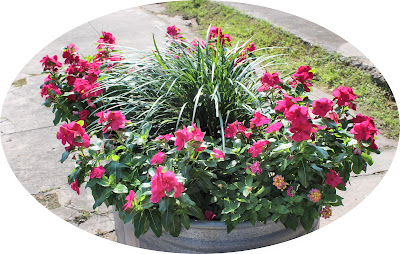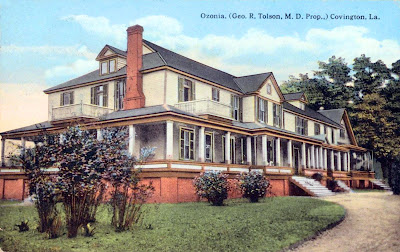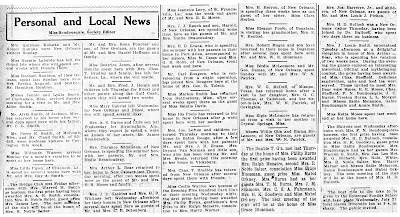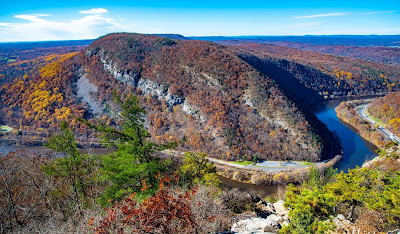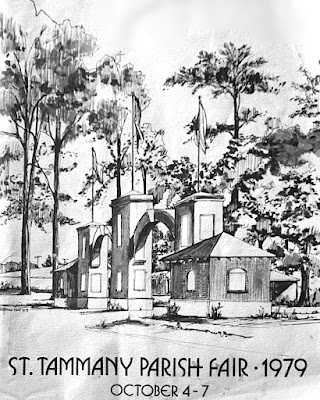In 2003 Don Sharp spoke to the St. Tammany Historical Society about "Gunboats and Block Ships on the Tchefuncte River."
Saturday, July 31, 2021
Don Sharp Speaks to Historical Society
Friday, July 30, 2021
100 Years Ago This July 30, 2021
What was going on 100 years ago this week? CLICK HERE for a link to the St. Tammany Farmer Issue of July 30, 1921. The link is provided by the Library of Congress and its Chronicling America service.
Click on the sample images below to see larger versions.
Thursday, July 29, 2021
Tammany Trace Map
About a year ago some Tammany Trace enthusiasts asked me to draw a cartoon map of the Trace and the landmarks and other fun things to do along the way. Here it is. Click on the image to make it larger.
Wednesday, July 28, 2021
The Covington Cantonment
For a brief time, the Covington area had a military cantonment on the Little Bogue Falaya River, just a few miles upriver from Claiborne Hill. It was located where the "Old Military Road" branches off and heads up to the Bogue Chitto River.
Don Sharp in his research says the following:
In 1805 a crossing over the Bogue Falaya River at Covington was located on land owned by Massey West Baker, and a wooden bridge was built at the site. Things began happening quickly in that area as new settlers came in.
The military cantonment was established in 1811 with the cooperation of Governor Claiborne of Louisiana and Governor David Holmes of Mississippi Territory. Lt. Colonel Leonard Covington of the U. S Army assigned the 3rd Regiment stationed in the Mississippi Territory for the job. Barracks for the troops and housing for Officers were built five miles from the Bogue Falaya Fork on the road to the settlements northeast on the Bogue Chitto River.
Covington is at the blue dot in the lower left corner, the location of the abandoned cantonment is the red mark at the top of the map, and Abita Springs is located at the green dot, lower right. The New Orleans railway line is located across the bottom (although it was not there at the time of the cantonment.) Of interest are the dotted lines, showing the roads to Pearlington (Ms.) at bottom, and the road to Bogue Chitto (Military Road La. Hwy. 21)
A declaration of War with Great Britain was received in July, 1812, and the Military Cantonment on the road between the Bogue Falaya and Bogue Chitto Rivers was closed because the troops were needed elsewhere. The Detachment of the 3rd Regiment stationed at the Cantonment was recalled back to Mississippi Territory.
In 1813 Governor Claiborne wrote to Governor Holmes of the Mississippi Territory and tells Holmes that since the Cantonment was closed on the Little Bogue Falaya roving bands of Choctaws have become increasingly hostile along the area of the Bogue Chitto River.
On November 29, 1814, General Jackson and five aides, including Major Howell Tatum,
who kept a dairy, came down the Military Road from the Bogue Chitto
River settlements. They passed the abandoned Cantonment at the crossing
of the Little Bogue Falaya and entered the newly dedicated town of
Wharton.
It was Samuel Ott who had the saw mill next to the "old
cantonment" that was mentioned in Howell Tatum's diary, and Ott's
property is clearly marked on the Tobin map shown above.
A hundred years later, in 1916, there was a small group of Louisiana Marines stationed at Demourelle's on the Bogue Falaya River a few miles south of Covington.
See also:
The Early Settlement of the Tchefuncte River Corridor
The Timeline Along the Tchefuncte River Corridor
Major Tatum's Whirlwind Tour Through St. Tammany
River Landings Map
Madisonville's Navy Shipyard
Don Sharp has written some amazing material about the navy shipyard on the banks of the Tchefuncte River just a mile or so north of Madisonville.
Here are a couple of links to his information.
The Naval Shipyard and Its Personnel
The Establishment of the United States Navy at New Orleans, after the Louisiana Purchase, and its Influence on West Florida
Tuesday, July 27, 2021
Downtown Sidewalk Flower Bins
Downtown Covington is covered with flower boxes filled with all kinds of colorful blooms and green leaves. Sort of brightens the day after several of drenching rains.
And, of course, the crape myrtles are back...
Monday, July 26, 2021
Ten Years Difference
Here is an aerial picture of the eastside entrance to Covington in March of 1965. Click on the images to make them larger:
Ten years later, here is another aerial picture, zoomed in on the Boston St./Lee Lane intersection.
Sunday, July 25, 2021
Ozonia Health Resort, a Covington Tradition
Click on the images to make them larger.
The tables were supplied with the best the market affords and the purest of artesian water, the Ozonia promised. "Modern in every aspect, sanitary plumbing, gas, hot and cold water baths, here there is no danger of malaria or yellow fever."
Located on America Street at the corner of 17th Avenue, the Ozonia Rest Cure conducted by Dr. Geo. R. Tolson was a beautifully situated private home-like resort for those desirous of "real rest and recreation."
It was situated right in the heart of the Ozone belt on the outskirts of Covington. The grounds were laid out as a natural park and comprised twelve acres overlooking the scenic Bogue Falaya River. Through these grounds were well-kept walks and drives and an ideally rustic environment. The grounds were "delightfully" shaded with oaks, magnolias, pines, and other trees.
The water supply was touted as abundant and perfectly pure; home comforts, home cooking made the Ozonia Rest Cure a place never to be forgotten. The house was open throughout the year and had accommodations for as many as thirty guests. The owners assured guests that there was a "perfect" system of heating, hot and cold baths and other conveniences.
The Ozonia was just one of several facilities in Covington and Abita Springs where visitors could recuperate from illness, stress, and various addictions. The right combination of pine-scented air, pure water, the rivers, the oak trees and the flowers helped many thousands of sick and over-stressed people recover their health and balance.
Information source:
Along The Line - Covington
Saturday, July 24, 2021
Lacombe People Pictures- 1976
Forty-five years ago, in 1976, the community of Lacombe celebrated the American Bicentennial. Programs were held, a museum was established, festivities flourished, and a book was published telling about the history of the area, the homes, the scenic beauty and the people.
Here are a couple of pages of pictures of the people of Lacombe from that book. Click on the images to make them larger.
Tom Aicklen put together the book, and it was quite a treasure trove of research, pictures, and old documents. The library probably has a copy for folks who want to go see the whole publication.
Thursday, July 22, 2021
100 Years Ago This July 23, 2021
What was going on 100 years ago this week? CLICK HERE for a link to the St. Tammany Farmer Issue of July 23, 1921. The link is provided by the Library of Congress and its Chronicling America service.
Click on the sample images below to see larger versions.
 |
Wednesday, July 21, 2021
Major Tatum's Whirlwind Tour Through St. Tammany
In his journal, Tatum describes crossing a number of creeks, some with settlements, along the way while heading to the Chifonta (Tchefuncte) River.
In his own words:
"He states it to be 10 or 12 miles to its junction with Pearl river," Tatum says, speaking of the Bogue Chitto River. "It contains a narrow strip of good lands on each side and is well settled near the creek, on both sides. Big Creek is the English of Bogue Chitty, or Chitta."
"It is 80 miles from hence to Baton-Rouge---16 1/2 miles to the Town of Wharton (Covington) on the waters of Chefonta, and 24 1/2 or 25 miles to Madisonville 2 miles above the mouth of Chefonta. On this day the party had to swim three creeks.
"Proceeded from Alston's and crossed the Creek at 6 o'clock A. M. Passed over a good piece of Bottom Land and swam a Bayou at the extreme edge at William Roses plantation at about 3/4 miles. Passed the old cantonment on Little Feliah (Falaya) at 11 miles.
Little Bogue Falaya Saw Mill
"Near this place there is an excellent Saw-Mill on the same creek. Proceeded in all 16 1/2 miles to the Town of Wharton on Big Feliah (or Big Long Creek) a fork of the Chefonta river. The Indians call both these creeks Bogue Feliah, and distinguish them by the Greater & Smaller, or Big Or Little, and these names are still retained by the settlers.
Covington Is Described One Year After Its Founding
"Wharton is a small new town containing but a few ordinary buildings. It is the seat of justice for the county in which it stands, and is situated at the head of navigation, on the bank of the creek. Sloops & Schooners ply between this place and the bridge on the Bayou St. Johns, two miles distant from the Town of Orleans.
"The lands from near Alstons (say from Roses) are very poor and the growth altogether pine. About 5 miles of the distance between his residence and the Cantonment has been laid nearly bare of Timber by a severe Hurricane.
"The lands from Wharton to the Town of Madisonville are a mixture of Pine and Oak and contain several tolerable farms & plantations.
"The whole of this route contains excellent range for Black Cattle which has become an object of primary importance with the settlers in this quarter, cattle being considered as a species of circulating medium in most of their contracts. In fact, this currency circulates pretty generally from hence to, and on, the waters of Tombigby & Mobile rivers."
Major Tatum continues his narrative: "From Wharton proceeded to Madisonville & halted for the night, on the way crossed the Main Chefonta river (about 60 to 80 paces wide) at 3 miles.
"It is estimated that the whole length of this river, on a direct line tuning from So. East to North West does not exceed 30 miles. The Course traveled this day was about So. So. West.
Major Tatum continues:
"It is evident from this statement, that the growth prosperity of this place must eventually depend upon the whims and caprices of mankind, when it is considered, in addition, that the country around will scarcely ever be able to produce more than the necessary provision for the support of life. Great quantities of Tar-Pitch and Turpentine might be prepared for use and exportation in the adjacent country, but, I apprehend a new supply of (more industrious) settlers must first inhabit this country.
November 30th, 1814
"Embarked at 10 o'clock A. M. on board of (William) Collins' Packet and proceeded across the lake to Fort St. Johns at the mouth of the Bayou distant 22 miles at which place we arrived about 8 o'clock P. M."
End of Major Tatum's references to St. Tammany
Tatum dated his field report at New Orleans, Feb. 20, 1815, and four months later on June 15 resigned from military service.
Later, "in a dispute over certain events of the New Orleans campaign, Jackson in 1817 referred his interrogators to Tatum's journal as the work of a man "whose impartiality is proverbial," the ncpedia.com article went on to say.
Tuesday, July 20, 2021
St. Tammany Day Is May 1
Way back in 1777, the Continental Congress, meeting in Philadelphia, voted to set aside the first of May to honor the Lenape sachem Tamanend, the Native American chief who made a Great Treaty with William Penn at the founding of Pennsylvania.
According to Gus Wiencke "Tamanend was a partner with William Penn in a boldly conceived agreement dated
1683 that Europeans and Indians would live together in peace as long as the
creeks and rivers run and while the sun, moon, and stars endure.
"As an Indian, Tamanend trusted Penn and his lofty ideal of a commonwealth of
freedom, peace, and tolerance for all inhabitants," Wiencke stated.
Tamanend Celebrated
Residents of the new nation recognized Tamanend as the Patron Saint of America, calling him "St. Tammany," and May 1 is celebrated in numerous states even today, especially in the state of Pennsylvania, as "St. Tammany Day."
He became a legend, and years later St. Tammany Parish was named after him to recognize and honor the Native American heritage of the St. Tammany area.
Re-establishing the Continental Congress' Tribute
On March 26, 2003 U.S. Representative David Vitter of Louisiana's First Congressional District introduced a Concurrent Resolution into Congress that would have made May 1 of that year "Tamanend Day" nationwide.
The proposed Concurrent Resolution aimed to declare St. Tammany Day on May 1, 2003, as a national day of recognition for Tamanend and the goals and values he represented.
The resolution read in part as follows:
"Whereas in 1810, President James Madison declared the Territory of West Florida to be a part of the Louisiana Purchase, and in 1811, William C. C. Claiborne, the first American territorial Governor of Louisiana, named the area north of Lake Pontchartrain as ‘St. Tammany Parish’ in honor of the saintly Amerindian Tamanend, who was a sachem of the Lenni Lenape;
"Whereas Tamanend is admired and respected for his virtues of honesty, integrity, honor, fairness, justice, and equality for the common person;
"Whereas, in colonial times, May 1st was celebrated in honor of Tamanend and the common person; and
"Whereas the St. Tammany Parish Council of St. Tammany Parish, Louisiana, has passed a resolution designating May 1, 2003, as St. Tammany Day, and urging the reinstatement of May 1st as a national day of recognition for Tamanend and the values he represented.
Resolved by the House of Representatives (the Senate concurring), That Congress supports the goals and ideals of St. Tammany Day as a national day of recognition for Tamanend and the values he represented.
-----------------------------------------
Aicklen pointed out that St. Tammany Day (May 1) is also the first day of National Tourism Week (May 1 - 7). That first week of May, starting off with St. Tammany Day followed by six days of promoting the many unique tourist attractions of the parish, could become an annual event spotlighting all of St. Tammany's outstanding people and places.
See also:
The Legend of St. Tammany's Name
Monday, July 19, 2021
Lacombe Heritage Discussed
St. Tammany Parish President Mike Cooper met with Lacombe area resident Tom Aicklen Monday afternoon to discuss ways in which to highlight Lacombe area heritage. They looked at a number of potential ways to help Tammany Trace visitors become aware of the history of the parish as they pass through some of the most scenic and culturally significant locations between Slidell and Covington.
Aicklen has over the years developed several projects in which the area heritage could be showcased, either through informational display boards on Tammany Trace, a live theatrical performance, or a television interview program with local residents familiar with historical points of interest in St. Tammany and across the Florida Parishes.
He is associated with the Lacombe Heritage Center and has written grant applications to foster appreciation of the environmental, historical, and cultural attractions of the Lacombe area.
See also:
Tom Aicklen Promotes Heritage
Choctaws Share Heritage at Lacombe Museum
Sunday, July 18, 2021
Suzanne King, Artist & Community Promoter
One of Covington's most prolific and appreciated artists is Suzanne King, not only for her skill and stylish technique, but also for her variety of work for a number of community organizations. The ChefSoiree, the St. Tammany Parish Fair Association, the Covington Heritage Foundation, and countless others have turned to her for special projects.
The St. Tammany Art Association has exhibited her mixed media works, and she was written up in the March 2015 issue of Inside Northside Magazine, as the artist who created the poster for that year's ChefSoiree event. CLICK HERE to read that article.
Her longtime devotion to producing award-winning fair posters is well-known, and in 2013 she created the memory-saturated Covington Bicentennial Poster.
She attended evening art classes at Tulane in the early 1970s, and pursued photography, house renderings, silkscreen posters, pottery, and etchings while participating in numerous local and regional exhibits, winning several awards.
From 1992-95, Suzanne taught art at the expatriate school in Shekou, People's Republic of China. After traveling to many fascinating places in the world during the 1990s and exploring other art forms, she has returned to drawing and mixed media/collage/assemblage pieces combined with elements of graphics, a favorite form of artistic expression.
A solo show at the St. Tammany Art Association was a highlight of 2015, after which she completed illustrations for two children's books for local authors: The Mystery of the Missing Smile by Carroll Devine and New Orleans - 300 and Counting.... by Alice Couvillon and Elizabeth Moore.
She recently created Christmas cards for the Covington Heritage Foundation's History and Holly Home Tour, depicting the two churches on that year's tour, Covington Presbyterian and St. Peter Catholic Church.
In 2015, an article about her written by Kevin Chiri appeared in the St. Tammany West newspaper.
Here are several excerpts from that article:
Popular Covington artist Suzanne King is leaving legacy in parish with intriguing artwork
"King is unquestionably recognized as one of the top artists in St. Tammany Parish and has been exhibiting her extraordinary work locally for years through many different outlets. Describing herself as a “mixed media artist, she delights locals who have enjoyed her work for many years."King said she has always enjoyed the opportunity to use her art to exhibit many
different things in surprisingly interesting ways.
“I like learning and I see beauty and art in things that many people would
never notice,” she said. “I noticed a birds nest the other day and was
fascinated to see how the bird created it. I saw a dead tree recently and
thought it was beautiful when someone else didn’t see anything special about
it.
“I have always looked at things differently, but I guess that’s what most
artists do and that’s where the creative side comes through,” she added.
"King has been a lifelong resident of the Covington area, graduating from Covington High in 1963 and doing the usual things in school that predicted a career in art.
Drawing has always been King’s strong suit, Chiri wrote. “I’ve never stopped learning–that is what I enjoy in life,” she said. “I took
etching classes at Tulane when I worked at Shell, I love photography and have
worked at that, I love doing house renderings and I even learned guitar and
sign language.
Back in St. Tammany Parish in 1995 she has spent the past 20 years becoming
very involved in the community here, supporting numerous charitable events and
organizations through her work. She was among the founding members of the
Covington Business Association and continually finding new ways to draw and display her work, even
becoming the artist who draws the pictures on the pizza boxes for Covington’s
“Pizza Man.”
“I’m sure a lot of people will be surprised that I’m the one who does the Pizza
Man box art,” she added with a smile. “I enjoy it since it’s one more way to do
something with my art. As I said, I love discovering new things to work with,” she concluded.
CLICK HERE to view her artwork on display at the St. Tammany Art Association
Here are several of her pizza boxes masterpieces:



















